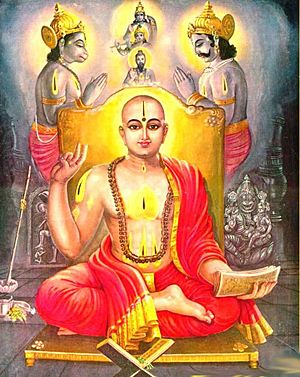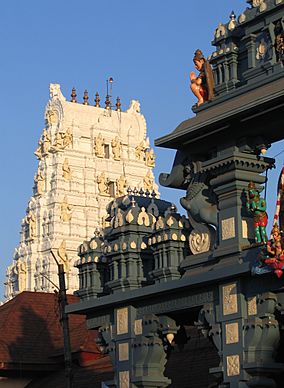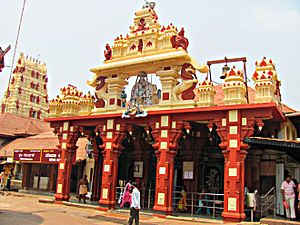Madhvacharya facts for kids
Quick facts for kids Madhvacharya |
|
|---|---|
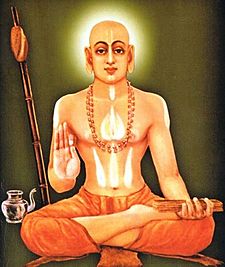 |
|
| Birth Date | c. 1199 (or 1238) Pājaka, near Udupi Karnataka |
| Died on | c. 1278 (or 1317) |
| Birth name | Vāsudeva |
| Guru/teacher | Achyuta-preksha |
| Philosophy | Tattvavada (Which later popularly came be known as Dvaita Vedanta) |
| Titles/honors | Pūrṇa-prajña Jagadguru |
Madhvacharya (IAST: Madhvācārya; Sanskrit pronunciation: [mɐdʱʋaːˈtɕaːɽjɐ]; born around 1199 or 1238 CE, died around 1278 or 1317 CE) was an important Indian philosopher and religious leader. He is also known as Purna Prajna and Ānanda Tīrtha. Madhvacharya was the main supporter of the Dvaita school of Vedanta, which means "dualism." He called his philosophy Tattvavāda, meaning "arguments from a realistic point of view."
Madhvacharya was born in the 13th century on the west coast of Karnataka state in India. As a teenager, he became a Sanyasi (a monk). He joined a group led by the guru Achyutapreksha. Madhva studied many classic Hindu philosophy texts. He wrote important comments (called bhasya) on the Principal Upanishads, the Bhagavad Gita, and the Brahma Sutras. He is believed to have written 37 works in Sanskrit. His writings were very short and to the point. His most important work is the Anuvyakhyana, which adds to his comments on the Brahma Sutras. In some of his writings, he said he was an avatar (a special form) of Vayu, the wind god, who is the son of god Vishnu.
Madhvacharya did not agree with the teachings of Adi Shankara's Advaita Vedanta and Ramanuja's Vishishtadvaita Vedanta. He traveled across India many times. He visited places like Badrinath, Varanasi, and Kanyakumari. During his travels, he took part in many philosophical debates. He also visited Hindu learning centers. Madhva started the Krishna Mutt at Udupi in 1285 CE. He placed a special statue (called a murti) of Krishna there, which he brought from Dwarka, Gujarat.
Madhvacharya's teachings are based on the idea that the Atman (the individual soul) and the Brahman (the ultimate reality, God Vishnu) are completely different. He believed they are two separate, unchanging realities. The individual soul depends on Brahman but is never the same as Brahman. His school's idea of dualism was different from the monist teachings of other Vedanta schools. These included Advaita's idea of non-duality and Vishishtadvaita's idea of qualified non-duality. Madhva taught that true freedom (liberation) can only be achieved through God's grace. The Dvaita school, started by Madhva, had an impact on Vaishnavism and the Bhakti movement in medieval India. It is one of the three most important Vedānta philosophies.
Contents
Madhvacharya's Life Story
The exact year Madhvacharya was born is not clear. Many sources say he lived from 1238 to 1317 CE. However, some sources suggest he lived from 1199 to 1278 CE.
Madhvācārya was born in Pajaka, a village near Udupi. This area is now part of the Karnataka state in India. People traditionally believe his father's name was Naduillaya. His mother's name is not certain, but some sources say it was Satyavati or Vedavati. He was born into a Tulu-speaking Brahmin family and was named Vāsudeva. Later, he became famous by the names Purnaprajna, Anandatirtha, and Madhvacharya. Pūrnaprajña was the name he received when he became a sannyasa (monk) as a teenager. When he became the head of his monastery, he was given the name "Ānanda Tīrtha." All three of these later names appear in his writings. Today, he is most commonly known as Madhvācārya or Madhva.
Madhva started school after his Upanayana ceremony at age seven. He became a monk or Sannyasi when he was a teenager, even though his father first disagreed. He joined an Advaita Vedanta monastery in Udupi. His guru (teacher) was Achyutrapreksha. Madhva studied the Upanishads and Advaita texts. However, he did not agree with the Advaita idea that the human soul and God are one. He often had disagreements with his guru. He eventually left the monastery and started his own movement called Tattvavada. This movement was based on the idea of dualism (Dvi), which states that the human soul and God (Vishnu) are two different things. Madhva never mentioned Achyutrapreksha as his guru or his past monastery in his own writings. Madhva was known for being very smart in philosophy. He was also said to be tall and strong.
Madhvacharya did not create a specific matha (monastery) just for Dvaita philosophy. However, his students later formed a line of Dvaita scholars. These included Jayatirtha, Sripadaraja, Vyasatirtha, and others. They continued Madhva's teachings.
Many biographies have been written by Madhva's students and followers. The most well-known and trusted one is the Madhvavijaya. This Sanskrit biography has sixteen parts and was written by Narayana Panditacharya. He was the son of Trivikrama Pandita, who was a student of Madhva.
Incarnation of Vayu, the Wind God
In several of his writings, Madhvacharya said he was the third avatar (special form) of Vayu, the wind god. Vayu is considered the son of Vishnu. This means he believed he was Hanuman (the first avatar of Vayu) and Bhima (a hero in the Mahabharata and the second avatar of Vayu). In one of his comments on the Brahma Sutras, he said his writings were true because he had met Vishnu himself. Madhva believed he was a link between Vishnu and people who followed Dvaita. He saw himself as guiding them on their journey to Vishnu.
Madhva is said to have performed several amazing feats during his life. These include turning tamarind seeds into gold coins. He also supposedly ate four thousand bananas and thirty large pots of milk in one sitting. People also say he fought and won against robbers and wild animals. He is said to have crossed the Ganges river without getting his clothes wet. Another story tells how he gave light to his students from his big toes' nails when their lamp went out at night.
Madhvacharya is also said to have quoted verses from his own special versions of scriptures. He also quoted from unique books like Kamatha Sruti. His followers believe his interpretation of the Balittha Sukta proves he was an incarnation of Vayu. This interpretation is seen as very unique compared to standard explanations.
Madhvacharya's Writings
Thirty-seven Dvaita texts are believed to be written by Madhvacharya. Among these, thirteen are bhasya (reviews and comments) on the earliest Principal Upanishads. He also wrote a Madhva-bhasya on the Brahma Sutras, which is a key text for the Vedanta school of Hinduism. Another important work is his Gita-bhasya on the Bhagavad Gita. He also wrote a comment on forty hymns of the Rigveda. He created a poetic review of the Mahabharata and a commentary called Bhagavata-tatparya-nirnaya on the Bhagavata Purana. Besides these, Madhva also wrote many stotras (hymns) and poems. These texts focus on bhakti (devotion) to Vishnu and his avatars. His masterpiece is considered to be the Anu-Vyakhyana, which is an addition to his comments on the Brahma Sutras.
Madhva's Philosophy: Key Ideas
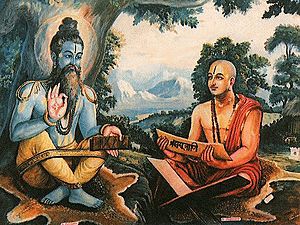
The main ideas of Dvaita Vedanta, also known as Dvaitavada and Tattvavada, come from Madhvacharya. His philosophy strongly supported the idea of complete dualism. Madhva's work is often compared to the ideas of Shankara's Advaita Vedanta (which teaches oneness) and Ramanuja's Vishishtadvaita Vedanta (which teaches qualified oneness).
How We Know Things (Epistemology)
Madhva called the study of knowledge Anu pramana. He accepted three main ways of gaining correct knowledge, called pramānas. This is different from the Charvaka school, which accepted one, and the Advaita schools, which accepted six.
- Pratyaksha (प्रत्यक्ष) means perception. This is how we know things through our senses (like sight or touch) and through our minds.
- Anumāna (अनुमान) means inference. This is when you reach a new truth by thinking about what you have observed and what you already know. For example, if you see smoke, you can guess there is fire. This method has three parts: a guess (hypothesis), a reason, and examples.
- Śabda (शब्द) means relying on words or the teachings of trusted experts from the past or present. In Madhva's Dvaita tradition, this is also called Agama. It includes all the Vedas. This idea means that people need to know many facts. Since we have limited time, we can only learn a small part directly. So, we rely on what trusted experts have said.
Madhva and his followers also talked about kevala-pramaana. This means "knowing an object exactly as it is." It is different from the anu-pramana mentioned above.
Madhva's Dvaita school believes that Vishnu, who is also known as Hari, Krishna, Vasudeva, and Narayana, can only be truly known through the correct understanding of the Vedic scriptures. Madhvacharya taught that Vishnu did not create the Vedas, but he is the teacher of the Vedas. Madhva's school says that knowledge is naturally correct. It also states that the person who knows and the thing that is known are both truly real and separate. Madhvacharya believed that both the ritual part (karma-kanda) and the knowledge part (jnana-kanda) of the Vedas are equally important and connected. Like the Mimamsa school, Madhvacharya believed that the Vedas have no single author. He thought their truth is found in all their parts.
Understanding Reality (Metaphysics)
Madhvacharya believed that reality is made of many different things. He said there are two main types of reality, called tattvas. These are svatantra tattva (independent reality) and Template:IAvatantra tattva (dependent reality). In Madhvacharya's view, Ishvara (God, as Vishnu or Krishna) is the cause of the universe and the only independent reality. The universe that was created is the dependent reality. It is made up of Jīva (individual souls) and Jada (matter, or physical things). Madhvacharya taught that individual souls are many, different, and real. He also said that Jīvas (souls) can feel and think, but matter cannot.
Madhva also explained five main differences (pancha-bheda) between God, souls, and material things: (1) Differences between material things themselves. (2) Differences between a material thing and a soul. (3) Differences between a material thing and God. (4) Differences between individual souls. (5) Differences between a soul and God.
These differences are not just temporary or practical. They are a natural and unchanging part of everything. Madhva called this Taratamya, which means "gradation in pluralism." He believed that no two objects are exactly alike, and no two souls are exactly alike. All souls are unique, which is seen in their different personalities. He used an example: the sea is full, a tank is full, and a pot is full. All are full, but each "fullness" is different.
Madhvacharya also believed that even in liberation (moksha), the happiness each person feels is different. It depends on how much knowledge and spiritual perfection they have. He said this liberation can only be achieved through the grace of God Vishnu.
The Nature of God (Brahman)
Madhva saw Brahman as a being who enjoys his own happiness. He believed the whole universe develops from a cloudy, unformed state. God appears from time to time to help this development. According to Madhva, God mainly appears in four forms as Brahman: Vasudeva, Pradyumna, Aniruddha, and Sankarasana. These forms are responsible for saving, creating, supporting, and destroying parts of the universe. God also has many other forms, and all of them are equally powerful. Brahman is the creator of the universe. He has perfect knowledge, perfect understanding, and perfect power. He is also separate from souls and matter. To achieve liberation, just understanding God as the creator is not enough. The individual soul must feel love, attachment, and complete devotion to Him. Only God's grace leads to freedom, according to Madhva.
Madhvacharya's idea of Vishnu as Brahman is similar to the concept of God in many major world religions. Some early European scholars thought Madhva might have been influenced by Christianity. However, later studies have shown this theory is not correct.
How to Achieve Freedom (Soteriology)
Madhvacharya believed that Jnana Yoga (the path of knowledge) and Karma Yoga (the path of action) were not enough to reach liberation without Bhakti (devotion). To Madhva, Lord Vishnu was the highest God. He taught that Vishnu can only be reached through Vayu, the son of God. Madhva also stated that faith leads to God's grace, and God's grace leads to the soul's liberation.
For Madhvacharya, knowing God was not just about understanding a concept. It was about feeling attraction, affection, constant attachment, loving devotion, and completely surrendering to God's grace. He disagreed with ideas that said knowledge alone brings freedom. Instead, he believed it is God's divine grace through Bhakti that frees the soul. Madhva thought that God hides reality by creating Maya (illusion) and Prakriti (nature). This causes people to be trapped and suffer. Only God can free the soul. Liberation happens when, with God's grace, a person understands their true self and the true nature of God.
Good and Bad Actions (Ethics)
Madhvacharya believed that evil and suffering in the world come from humans, not from God. Every Jiva (individual soul) is responsible for its actions, not Jada (matter) or Ishvara (God). While Madhva said each person is truly responsible for their actions, he also said that the self is not completely independent. This is because, according to Madhva, the soul is influenced by senses, the body, and other material things, which he called gifts from God. People have free will, but they are also shaped by their natural character, tendencies, and past karma.
Madhvacharya stated, Yathecchasi tatha kuru, which means "one has the right to choose between right and wrong." Each person makes this choice and is responsible for it. Madhva did not directly answer the problem of evil. This problem asks how evil can exist if God is all-powerful, all-knowing, and all-good. However, Madhva's idea that souls have different natures from the start makes it less necessary to answer this problem directly.
Moral laws and good behavior exist, according to Madhva. He believed they are necessary to receive God's grace and achieve liberation.
Madhva's Views on Other Schools
Madhvacharya was a strong critic of other Vedanta schools. He also criticized other Indian philosophies like Buddhism and Jainism. He wrote arguments against 21 ancient and medieval Indian scholars. He did this to help build the foundations of his own school of thought.
Madhvacharya was especially critical of Advaita Vedanta. He even accused Shankara and Advaitins of being "deceitful demons" who taught Buddhism disguised as Vedanta. Advaita's idea of non-dualism says that Atman (soul) and Brahman are the same, full of happiness, and unchanging. It teaches that all souls and Brahman are connected as one, and there are no differences. Madhva, however, said that Atman (soul) and Brahman are different. He believed only Vishnu is the Lord (Brahman). Individual souls are also different from each other and depend on Vishnu. Madhva criticized Advaita for being like a version of Mahayana Buddhism, which he saw as having no real meaning. Madhva focused most of his criticism on Advaita. He wrote four major texts, including Upadhikhandana and Tattvadyota, mainly to criticize Advaita.
Madhvacharya also disagreed with some parts of Ramanuja's Vishishtadvaita. The Vishishtadvaita school, like Madhvacharya's Dvaita school, is a realistic way of thinking. It also says that Jiva (human souls) and Brahman (Vishnu) are different, and this difference never goes away. Both Madhvacharya and Ramanuja believed that God Vishnu alone is independent. All other gods and beings depend on Him. However, Vishishtadvaita teaches "qualified non-dualism." This means that souls share the same basic nature as Brahman. It also says that all human souls can reach the same level of happiness as God Himself. While Vishishtadvaita believed in "qualitative oneness and quantitative many-ness of souls," Madhvacharya believed in both "qualitative and quantitative many-ness of souls."
Shankara's Advaita school and Ramanuja's Vishishtadvaita school both assumed that all souls can hope for and achieve a state of joyful liberation. In contrast, Madhvacharya believed that some souls enjoy causing chaos and being irreligious. He even thought some souls are meant to be forever lost and condemned.
Madhvacharya's way of criticizing other schools was common in ancient and medieval India. He was part of the Vedanta school, which became very important after the Vedic period. His focus on the Advaita tradition shows that it was the most influential of the Vedanta schools.
Madhvacharya's Impact
Madhvacharya created a unique and new philosophy within Vaishnavism.
The Madhwa tradition encouraged devotion (Bhakti) and the search for knowledge. Madhvacharya and his monk followers spread the Dvaita Siddhanta through their comments and teachings. These writings were mainly in Sanskrit, so they were not easy for everyone to access. So, another group of followers, called Hari-Dasas, naturally developed. These were students or devotees of Madhva's philosophy. They studied the main books, learned philosophy, and practiced devotion while living normal lives. They dedicated themselves to serving God. These Hari-Dasas took on the job of sharing Madhva's teachings across the country. They used local languages like Kannada to do this. These missionaries helped break down barriers of caste and region. They practiced pure devotion and shared the wonders of Madhva's philosophy with common people through songs and other writings. These Hari-Dasas became known as the Dasa Section or Dasa-Kuta of the Madhwa tradition. This was different from the Vyaasa-Kuta, who were scholars and teachers of the original texts.
There is no difference between the Vyasa-kuta and Dasa-Kuta in their learning or approach to philosophy. The Vyasa-Kuta were scholars and teachers who believed in gaining knowledge in the traditional way. The Dasa-Kuta simplified this knowledge into devotion (Bhakti). The terms 'Dasaru' and 'Vyasaru' first became popular during the time of Purandaradasa and his teacher, Vyasaraya. Over time, 'Vyasakuta' meant the group of devotees who knew Sanskrit well and understood the philosophy from the original texts. Dasakuta or Dasa Dasapantha meant the group of devotees who shared the message of Dvaita philosophy through simpler local language songs and writings related to the Bhakti movement.
Other important groups within Vaishnavism had different ideas from Madhvacharya. For example, the Chaitanya group believed that only Krishna is the "Svayam Bhagavan" (supreme form of God). This is different from Madhva, who said that all Vishnu avatars are equal. Both groups, however, believed that strong devotion to God leads to spiritual freedom. Chaitanya Mahaprabhu (1496–1534) is said to have been a student of Isvara Puri, who was a student of Madhavendra Puri. Madhavendra Puri was a student of Lakshmipati Tirtha, who was a student of Vyasatirtha (1469–1539) from Madhvacharya's tradition. Madhva's Dvaita ideas have had the most influence on the Chaitanya school of Bengal Vaishnavism and in Assam.
A group of Gaudiya Vaishnavas from Orissa and West Bengal say they are followers of Madhvacharya. Madhva started the Udupi Krishna Matha, which is connected to a Krishna temple. Gaudiya Vaishnavas also worship Krishna.
Monasteries (Mathas)
Madhvacharya set up eight mathas (monasteries) in Udupi. He put eight of his students in charge of these monasteries. These Udupi Ashta Mathas are Palimaru matha, Adamaru matha, Krishnapura matha, Puttige matha, Shirur matha, Sodhe matha, Kaniyooru matha, and Pejavara matha. These eight monasteries surround the Anantheswara Krishna Hindu temple. The monasteries are arranged in a rectangle, and the temples are on a square grid. The monks in these monasteries are sannyasis (renunciates). Madhvacharya created the system for their studies and how leadership passes on (called the Paryaya system). Each monastery has a head monk called a Swamiji. This role rotates after a set period of time. The Swamiji leads daily Krishna prayers and annual festivals according to Madhva's tradition. The rituals for Krishna worship in Dvaita monasteries follow the steps Madhvacharya wrote in Tantrasara. This worship does not involve bali (sacrifice) or fire rituals. In the leadership change ceremony, the old Swamiji welcomes the new one. They then walk together to a statue of Madhvacharya at the entrance of the Krishna temple in Udupi. They offer water to him and show respect. Then, the old Swamiji hands over the same water vessel that Madhvacharya used when he passed on leadership of the monastery he founded. The monasteries also have kitchens, called bhojan-shala. Monks and volunteers run these kitchens. They serve food daily to about 15,000 to 20,000 monks, students, and visitors, without any social discrimination. During leadership ceremonies, over 80,000 people are served a vegetarian meal by the Udupi bhojan-shalas.
Madhvacharya also started a matha with his student Padmanabha Tirtha as its head. This was to spread Tattvavada (Dvaita) outside the Tulunadu region. He instructed his students Narahari Tirtha, Madhava Tirtha, and Akshobhya Tirtha to become the next leaders of this matha. According to Surendranath Dasgupta, Uttaradi Math is the main matha of Padmanabha Tirtha. It was later divided twice, creating three mathas. The other two are Vyasaraja Math and Raghavendra Math. The Uttaradi Math, along with Vyasaraja Math and Raghavendra Math, are considered the three most important centers of Dvaita Vedanta. They are often called Mathatraya. The leaders and scholars of these three mathas have been key in developing Madhva Dvaita Vedanta over the centuries. Among the mathas outside the Tulu region, Uttaradi Matha is the largest. All the mathas outside the Tulu region are connected to Padmanabha Tirtha in some way. Including the mathas in Udupi, there are twenty-four Madhva mathas in India. The main center of Madhva's tradition is in Karnataka.
Professor Kiyokazu Okita and Indologist B. N. K. Sharma say that monks (Sannyasis) in the Dvaita school of Vedanta belong to the Ēkadaṇḍi tradition. This is the same tradition as the Sanyasis of Advaita from Adi Shankara.
Film About Madhvacharya
In 1986, a film called Madhvacharya was released. It was directed by G. V. Iyer and was made entirely in the Kannada language.
See also
 In Spanish: Madhwa para niños
In Spanish: Madhwa para niños


